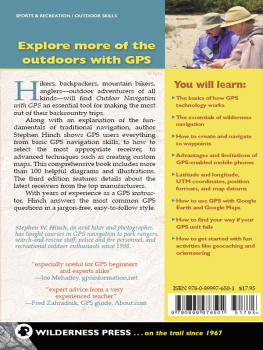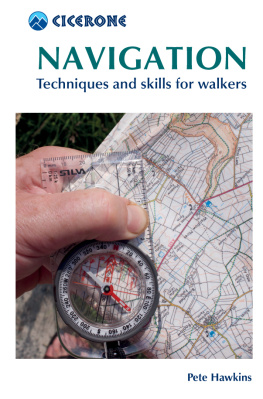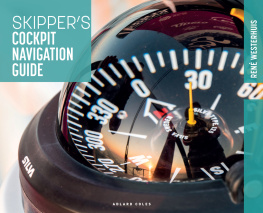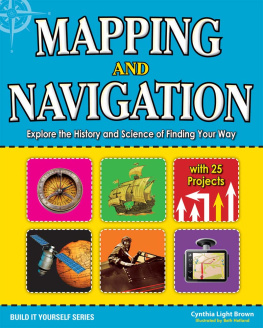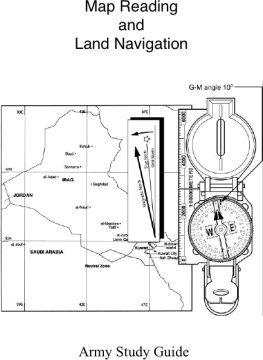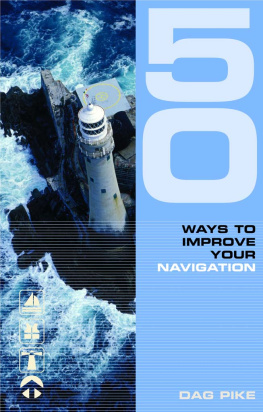

Outdoor Navigation with GPS
1st EDITION May 2004
2nd EDITION October 2007
3rd EDITION 2010
Copyright 2004, 2007, and 2010 by Stephen W. Hinch
Front and back cover photos copyright 2010 by Stephen W. Hinch
Interior photos, except where noted, by Stephen W. Hinch
Maps & illustrations: Stephen W. Hinch
Cover & interior design: Lisa Pletka
Layout: Larry B. Van Dyke
Editors: Roslyn Bullas and Laura Shauger
ISBN 978-0-89997-650-1
Manufactured in the United States of America
Published by: Wilderness Press
Keen Communications
2204 First Avenue South, Suite 102
Birmingham, AL 35233
(800) 443-7227
info@wildernesspress.com
www.wildernesspress.com
Visit our website for a complete listing of books and for ordering information.
Distributed by Publishers Group West
Cover photos: (top) Delicate Arch, Arches National Park: N38 44.617
W109 29.967; (bottom) GPS receivers: Garmin GPSMAP 60CSx,
DeLorme PN-40, Garmin Oregon 400t
All rights reserved. No part of this book may be reproduced in any form, or by any means electronic, mechanical, recording, or otherwise, without written permission from the publisher, except for brief quotations used in reviews.
SAFETY NOTICE: Although Wilderness Press and the author have made every attempt to ensure that the information in this book is accurate at press time, they are not responsible for any loss, damage, injury, or inconvenience that may occur to anyone while using this book or the products mentioned in this book. You are responsible for your own safety and health while in the wilderness. Be aware that the products covered here may have been updated or changed since this book was printed.
To Nicki, Juliana, and Greg
Acknowledgments
I d like to thank the many people who helped me make this a better book. I first thank my wife, Nicki, who once again provided immense support throughout the entire project and proofread every page. She knows a lot about the subject and has been an invaluable assistant in helping the students in my GPS courses understand the concepts of outdoor navigation. I would also like to thank Lincoln Turner and Joe Mehaffey, two people who provided valuable information for earlier editions that continues to be important here. Lincolns insight into traditional map-and-compass navigation has been especially valuable. Joes wide knowledge of GPS, gained as co-owner of the website www.gpsinformation.net, also has been of immense help.
GPS technology continues to improve at a rapid rate, and I am indebted to several industry experts for keeping me up-to-date. Dr. Frank van Diggelen of Broadcom, author of a definitive book on such arcane subjects as Assisted GPS and Long Term Orbits, was immensely helpful in my quest to understand those topics. Charlie Conley and his technical experts at DeLorme gave me invaluable insight into the workings of the latest multichannel receivers.
On the production side, Roslyn Bullas, associate publisher at Wilderness Press, and Laura Shauger, my editor, have been a pleasure to work with. Their suggestions and support have done a lot to improve the final book. Finally, I would like to recognize those people within the industry whose help over the years has been invaluable: Jake Jacobson and Jessica Myers of Garmin, Steve Wegrzyn and Luke Morris of Lowrance, Michelle Wilkinson of National Geographic, Debby Chen of Magellan/Fleishman-Hillard, Bryan Roth of Groundspeak, Inc., and Adriana De Paola of Revue Thommen AG.
Preface
N ot long ago, newspapers ran front-page articles about a hunter who had been lost for three days in snowy mountains during the middle of winter, supposedly because his GPS receiver had given him wrong directions. The only reason he survived was that he was accidentally discovered by a passing snowmobiler. Rangers who later tested his receiver found it was working fine; a more likely explanation was that he hadnt understood how to use it. But the story got wide publicity and did little to increase the publics confidence in GPS. Similar stories regularly make headlines. A driver in New York narrowly escaped death when he turned onto a railroad track in front of an oncoming train because his GPS receiver told him to turn. A family in Oregon was trapped overnight in snow because they followed the advice of their brand-new GPS receiver and took a shortcut over a remote Forest Service trail. In each case, the hapless travelers blamed their predicaments on GPS, not on themselves.
GPS manufacturers havent exactly helped the situation. Their user manuals tend to be simple pamphlets that dont even explain all of the receivers functions, let alone show you how to do anything useful like navigate to a destination and return safely. One of the most frequent laments in online reviews of GPS receivers is the lack of quality information in their user manuals.
Youd think that would worry GPS manufacturers. After all, newspaper headlines blaring, Lost Hiker Found Dead Clutching GPS, dont do the industry any good. But you cant really blame the manufacturers. GPS is used in so many different ways, from hiking in the woods to navigating aircraft to coordinating artillery strikes, that its not practical for a single instruction manual to cover all these uses and more.
To fill the gap, a thriving cottage industry of aftermarket books, videos, and hands-on instructional classes has emerged. But even here, you are likely to walk away confused. Many books treat GPS as an end in itself rather than as simply one tool to help you navigate. If your goal is to learn how to use GPS to find your way in the outdoors, you dont need to confuse things by learning how to do such things as survey an archaeological dig or dock a supertanker.
Thats where this book comes in. It is written expressly for the outdoor navigator. Youll learn how to do the important things in a simple, easily understandable way. Youll learn how to keep from getting lost, how to navigate both simple and complex routes, and how to use your GPS receiver in conjunction with those two other venerable tools of wilderness navigation, the map and compass. You wont be overwhelmed trying to understand the countless other GPS features youre unlikely to ever need.
Fortunately, when it comes to outdoor navigation, using a GPS receiver is not all that complicated. Thats true whether youre a hunter returning to your pickup after a day in the woods, a backpacker on a multiday trek, or a geocacher searching for hidden treasures in a local park. Dont worry if the instruction manual that came with your receiver doesnt show you how to navigate. Youll learn that here.
Which brings me to the next important topic: As Ive said, GPS is used in many different ways. The subject of this book is recreational outdoor navigation. Youll see how to find your way in the backcountry, but not how to navigate ships or aircraft. If you really want to use GPS to do something dangerous like land an aircraft in a hailstorm or row solo across the Atlantic, youll need expert instruction covering your specific needs.
TERMINOLOGY CLARIFICATION
Technically speaking, the term GPS describes the entire Global Positioning System. What you hold in your hand is a GPS receiver. Lots of people just call it a GPS, but Ill try to avoid that here. A slang term to describe a GPS receiver thats gained popularity in the geocaching community is GPSr. It remains to be seen how widely it will be adopted, so I wont use it. If you want to understand the many other GPS-related terms, read the glossary at the back of the book.

